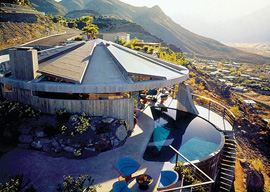
May 08, 2013

Elrod House
According to Chris Jepsen’s delightful Space Age City website, Googie architecture is a cross between the visions of The Jetsons and The Flintstones, with maybe some Polynesian volcano-god style tossed in, too. (Guys who fought in the War in the Pacific, the national epic of Southern California, came back with a taste for Tiki.)
To Jepsen, Googie embodies an entire eschatology:
Man left his caves and grass huts and through hard work and ingenuity has built an amazing modern world. Tomorrow he will conquer any remaining problems and colonize the rest of the galaxy. However, for all his achievements and modern science, man will never lose touch with the natural world and his noble roots.
Lautner was largely slighted or ignored by academia, and he seldom received commissions from committees. Instead, USC professor William Pereira, a sci-fi devotee, tended to get the big contracts in Southern California, such as for his Brutalist campus for the University of California at Irvine campus. (It’s best known for standing in for the dystopian monkey prison in Conquest of the Planet of the Apes.)
In contrast, Lautner’s clients were typically local businesses or individuals. He once said that his clients were “either rich bastards or poor geniuses.” Fortunately, there were enough of both in mid-century SoCal to keep Lautner afloat. For example, the immense Star Trek-like house Lautner completed in 1979 in Palm Springs for Bob Hope, whose main house was just off Riverside Drive, was recently put on the market for $50 million.
Lautner was constantly on the verge of going out of fashion. The populist popularity of his Googie commercial designs damaged the cachet of his upscale homes. In the 1970s, however, he managed to rebrand himself, not unreasonably, as an ecological architect“he’d always been brilliant at integrating interiors with California’s pleasant outdoors. Lautner’s ability to conjure up the design right for a unique site distinguished him from other strongly imaginative architects.
Back in the late 1970s, my friend Les, who grew up in Studio City two doors down from science-fiction novelist Jerry Pournelle, was determined to get a job with Lautner. The old man was once again out of style, but Les was convinced he was the greatest architect in Los Angeles. For a week, he sat in Lautner’s dusty, Philip Marlowesque waiting room, hoping Lautner would give him an interview despite his lack of architecture experience. Each day the curmudgeon would sweep past him without a glance. Finally on Friday, a draftsman didn’t show up for work. Lautner glanced up and muttered, “Do you know mechanical drawing? Well, make yourself useful.”
Les is an architect in London today.
In the Hollywood Hills looking north to Burbank is the most notorious Lautner home, the 1960 Chemosphere House which served as a bachelor pad in the Charlie’s Angelsmovie. For a young aerospace engineer who owned a sheer cliff, Lautner designed a flying saucer on top of a 30-foot-tall pole. The family of six rode a funicular up to their UFO.
Granted, the sensational Cinemascope-like views didn’t make up for the quotidian disadvantages of living in one of the inspirations for the Jetsons’ house. To make a Frisbee-shaped residence work, you would really need a flying car.
But back in Burbank in 1960, did anybody doubt that the advent of flying cars would be long delayed?
The future isn”t what it used to be, and that’s a shame.